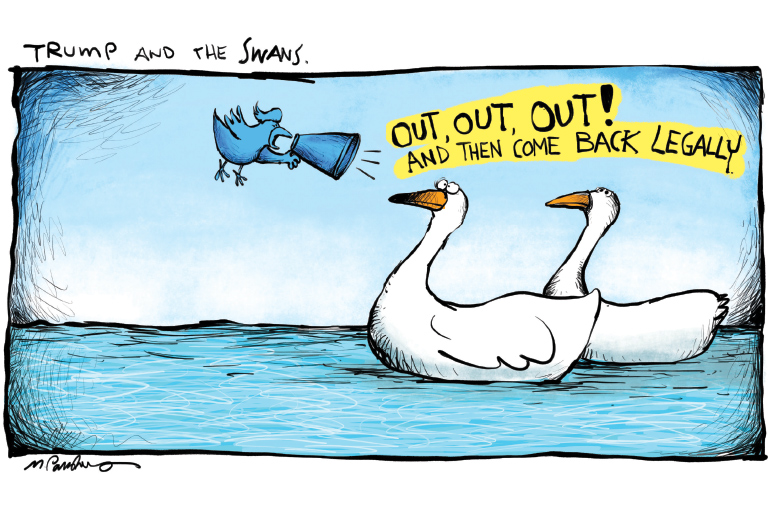Bugle Call: Kick Out Hamptons Mute Swans and Bring in Trumpeter Swans

You may remember the shocking attempt by the State of New York two years ago to pass laws ordering the slaughter of all the mute swans across the state. Here in the Hamptons, pairs of mute swans live majestically in town ponds in the center of our communities. They mate for life, and we watch them build nests and hatch their young, raise them and then parade with them around in our ponds, the little ones stringing along in a line behind their parents. Why kill them?
The authorities say the mute swans can turn quite vicious when you get too close, and that is true. They also say that when mute swans arrive at a pond where they want to settle, they completely take it over and drive off other birds and creatures that want to make nests there. They say mute swans eat voraciously tremendous amounts of food, plants, roots and things, and in doing so make a huge mess, leaving as much torn-up food uneaten as they eat. And they are not indigenous to America. Instead, they arrived here from Belgium in the 1890s, brought in cages by rich Europeans who built mansions in the Hamptons and felt that the Belgian mute swans would be beautiful decorations for the little ponds that grace our communities.
And then, this happened. Four years ago, a mute swan nesting in a pond in Chicago attacked and killed a kayaker. The man was not wearing a life vest and the swan pecked him until he fell overboard and then, as he struggled in the water, continued to peck him until, well, the man disappeared beneath the water and drowned. Enough was enough.
In the end, New York State backed off from their deadly plans for the mute swans. They did pass laws, but they are for someday in the future, and they will allow some to stay but not others. It seems that fight is over, at least for now.
Well, we all still visit our town swans from time to time. If the mute swans hiss, we back off. It’s a careful thing. And apparently this love affair we have with these waterfowl will continue for quite a while, anyway.
But now I have read a story in The New York Times on Tuesday that talked about another kind of white swan. It is called a trumpeter swan. It was the original indigenous species in the United States and Canada when the white men got here. Larger than the mute swan—is that possible?—they were virtually wiped out by 17th century European hunters who got here and decided to kill them and cook them, putting them on the bottom rung of the endangered species list in recent years. And yet, here they are in this story, surviving and now making a dramatic comeback in northern Michigan, Ontario, Canada and other places.

The comeback was begun by environmentalists in Michigan who began mating some of the few left, and then switched trumpeter eggs with mute swan eggs so the mutes would unknowingly hatch those eggs into ponds everywhere in Michigan. The American environmental program to do this ran out of money, but some Canadians took the unhatched eggs and, up in Ontario, tricked the local mutes into hatching them anyway, and in this way, every year, there are more and more trumpeter swans. There are hundreds, even thousands of them now, and some have even been seen now as far east as upstate New York. The Times interviewed a 95-year-old Canadian named Bev Kingdom, who has given names to all the trumpeter swans in her nearby pond. It’s quite something.
The beauty of trumpeter swans is unparalleled. They can weigh 40 pounds. They can spread their wings seven feet. They are the largest waterfowl in the world. And they even look stunning. They sport black feet and black beaks. They forage for grain left over in fields after the harvests. They eat daintily and they hold their necks in the heart shape just as mutes do. Trumpeters will back away from mutes, and will fly off to find new nesting grounds.
It occurred to me—a scandalous thought—that perhaps our mute swans could be replaced by these larger and even more beautiful trumpeters. They are peaceable swans. They make loud noises, beautiful, trumpeting noises. Would people object to the noise?
They are the original species. They are entitled. As a side note, I also read about another kind of big white swan, called a tundra swan. It is a smaller swan than either the trumpeter or the mute, and less spectacular. But it isn’t as beautiful. For example, instead of holding their necks in a graceful arch like one half of a heart as the mutes and trumpeters do, the tundras hold their necks straight up. Tundras bend their necks to nibble some food, then hold it in their beaks straight up. They then shiver to get the food down. No ballerinas, these swans.
There is also a long list of other creatures in our ponds. No tundras are here, but there are mallard ducks, canvasbacks, geese, herons, loons, egrets, etc. All have lived peaceably. But when mutes come…Well, recently environmentalists found a pair of mutes lovingly occupying a big nest they’d built in the center of a group of smaller nests now abandoned by geese who the mutes had scared off. I think that was in Michigan. This is a big problem.

As I began to look into this, I realized that there is only one person in the United States who should make this decision about who goes and who stays. It is Donald Trump. As you read about this further, you might try to second guess him and decide which creatures in the swan world are the Mexicans, or the Iranians, or the Muslims, or the African Americans, or the Chinese or the “dreamers.” Who among the swans is in the entertainment business or the media business?
There are snapping turtles in many of our ponds. They live just below the surface, coming up for air occasionally, but among other things, they feast on baby swan legs that paddle these darlings forward as they struggle behind their parents. The turtle bites can lead to disaster in the swan world. But the mutes soldier on. Those turtles are the predators of the mutes. And native, I believe. There are snakes in the ponds that slither about. And there are, up above, occasional groups of seagulls or shorebirds circling around eager to swoop down and grab the little fishes swimming peaceably in the ponds—all native fish—and fly off.
Little water bugs tiptoe along on the surface of the ponds, not bothering anybody. In the summer, there are mosquitoes.
The tundra swan speaks, making a strange “oo-oo-oo—oo” sound. The trumpeter is really loud, almost a shriek. The mutes can grunt and whistle as well as hiss. Otherwise they are silent.
The mute has an orange beak with a black knob atop it at the base, between the eyes. When the female is ready to lay eggs, the male’s black knob gets bigger. He becomes fiercer, defending the nest, sometimes to the death. You never know. And of course, obnoxious amounts of excrement from the mutes fouls the pond, and they don’t clean up after themselves.
When the female mate of either a mute or a trumpeter dies, the male often will choose a younger new female as a mate. If the death is a male, then the female will also choose a new mate, but if it is a younger male, the younger male will move into her nest rather than the other way around. Divorce is rare but not unheard of.
There are elvers in Town Pond—baby eels—which get born in a birthing spot in the Caribbean Sea and somehow get here, illegally, of course. There are alewives, a kind of fish. I think there are bunker fish.
There used to be along the shore of some of our ponds a variety of wetland plants including reeds, sedges, ladies tresses orchid and other rare wildflowers, but the mutes have got most of them.
So there you have it. We have to leave all this to our great leader. A wall? They’ll fly over it. Drones and soldiers? Maybe. Different numbers of different groups allowed? A maximum? Of course. This country is “full,” as Trump said last week. I think he was referring to water birds.




